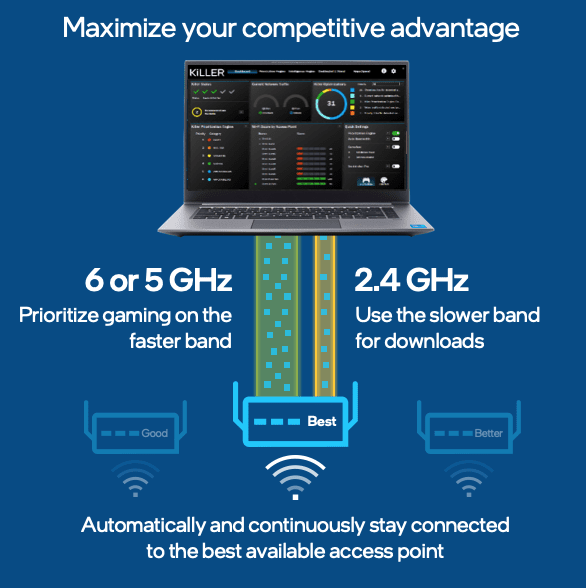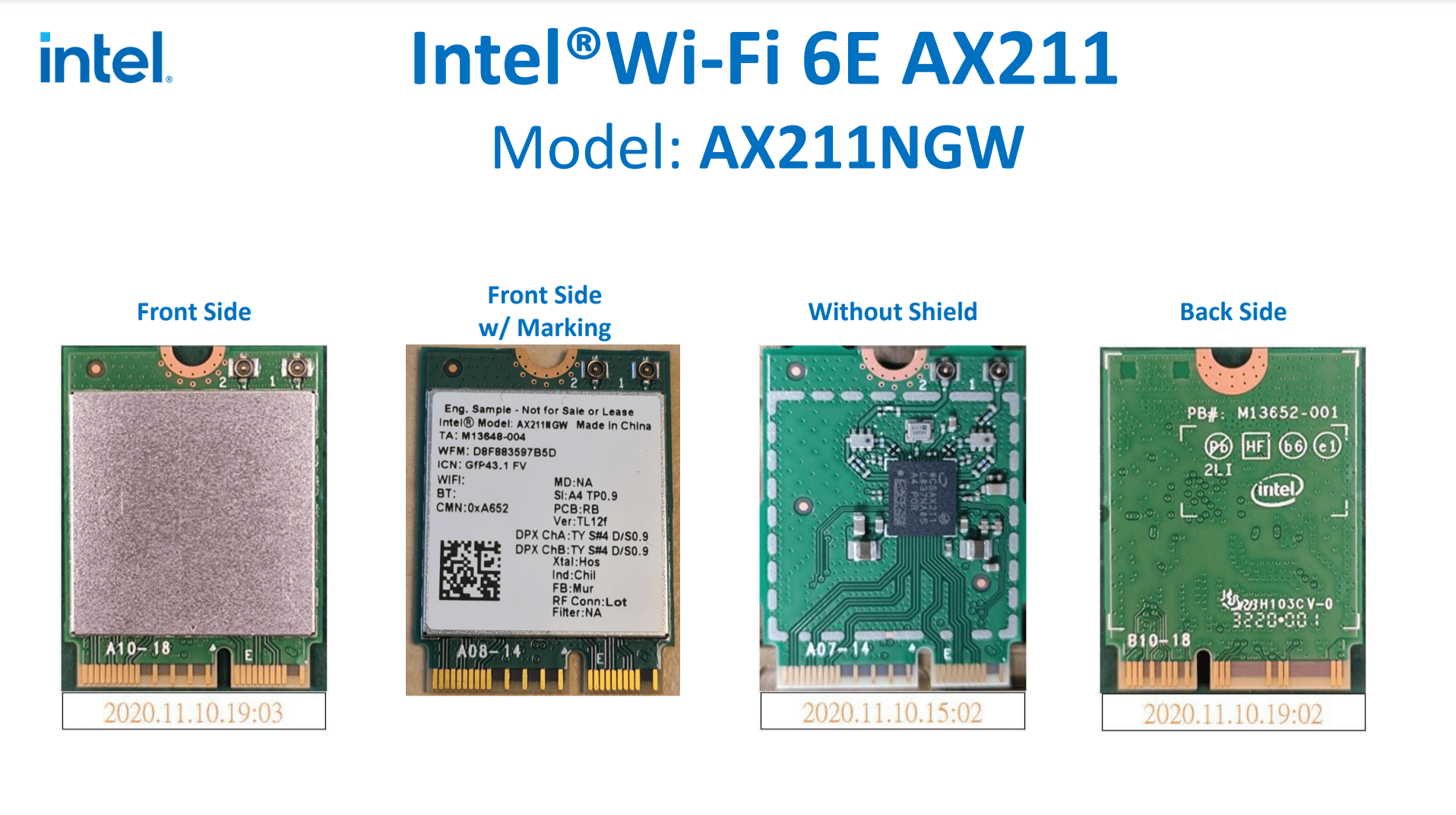Any links to online stores should be assumed to be affiliates. The company or PR agency provides all or most review samples. They have no control over my content, and I provide my honest opinion.
When I was updating my Wi-Fi drivers for the Netgear Wi-Fi 6E Orbi RBKE963 review, I came across some new products that Intel had quietly launched, the Intel AX411 and AX211.
Both of these products launched at the end of 2021, but there is hardly any information on them, and this comparison is somewhat limited until they become available to buy.
Previously, the upgrade from the AX200 to AX210 was the introduction of Wi-Fi 6E and the 6Ghz band, which is a significant upgrade if you have compatible networking gear.
CNVi
Before I do the other comparisons I will warn that it seems like both the AX211 and AX411 use the M.2: CNVio2 interface type. I had no idea what this was until I read this Intel thread
Basically, the AX211 is the CNVi Version of the AX210. The AX211 is missing some parts of a typical wifi card which is integrated into the CPU on modern Intel systems. In this case, the MAC, which is the part of the wifi stack that handles all the logic and talks to the CPU.
I am not 100% sure but Intel is basically vendor locking these modules for the recent Intel motherboards.
Not 4×4 or Wi-Fi 7
At first, I thought the Intel AX411 might be the holy grail of a 4×4 Wi-Fi module, but sadly, one of the things that Intel does reveal is that it is 2×2.
With a lot of talk of Wi-Fi 7 recently, this was the other obvious change. While I can’t 100% confirm this, neither the AX411 nor AX211 appears to introduce this. Intel have categorised these as part of the Intel Wi-Fi 6E (Gig+) Series
Double Connect / DCT

At CES 2022, Intel launched 12th Gen Intel Core mobile processors (for notebooks) with Wi-Fi 6E capabilities built-in, they made no mention about the above module names.
Part of this launch covered the new Double Connect technology, which allows a device to connect to two bands at the same time. It is advertised as allowing you to prioritise the faster 5Ghz/6Ghz band for gaming while using the 2.4Ghz band for downloads.
A lot of the CES announcement seemed to indicate that Intel is integrating the technologies they acquired from Killer into the new 12th gen Intel notebooks. As well as the Double Connect technology, Intel will launch their Intel Connectivity Performance Suite’ which in essence is the Killer connectivity suite that was used on many gaming laptops.
The Killer technology uses a sophisticated Wi-Fi traffic prioritisation engine to drive down online gaming latency by up to 70%.

Moving back to the AX411, under the product ordering page, this specifically states DCT, whereas the AX211 and AC210 lack this term. It is highly likely that this is referencing the new Double Connect technology.
Uplink MIMO
I managed to find one Intel thread about the AX211 and this confirms at least one difference with the AX210, and that is the support for uplink multiple-input and multiple-output. This allows it to support up to 8 streams of UL data from multiple stations improving UL network capacity in dense environments.
I would assume this is true for the AX411.
Price and Availability
At the moment, there is nowhere selling either of the new modules. Oddly, Intel indicates the wholesale price of the AX211 as being higher than the AX411.
If you don’t mind buying 100 at a time, then Mouser has the AX411 available for £1,263 for 100 units, but they don’t have the AX211, yet.
Aliexpress has the AX211 available to buy for £21.
The Aliexpress page states that the AX211 is only compatible with 10th Gen CPUs, they make no mention of Intel but it is safe to assume they mean the. I have ordered one, but I am not very optimistic about it working (I’m on AMD) or having much difference from my existing AX210.
Intel AX411 vs AX211 vs AX210 Wi-Fi 6E Specification Comparison
| Intel Comparison | Intel Wi-Fi 6E AX210 (Gig+) | Intel Wi-Fi 6E AX211 (Gig+) | Intel Wi-Fi 6E AX411 (Gig+) |
|---|---|---|---|
| Essentials | |||
| Product Collection | Intel Wi-Fi 6E (Gig+) Series | Intel Wi-Fi 6E (Gig+) Series | Intel Wi-Fi 6E (Gig+) Series |
| Status | Launched | Launched | Launched |
| Launch Date | Q4'20 | Q3'21 | Q4'21 |
| Weight (in grams) | 2.8 | 2.83 | 2.8 |
| Operating Temperature Range | 0°C to 80°C | 0°C to 80°C | 0°C to 80°C |
| Operating Temperature (Maximum) | 80 °C | 80 °C | 80 °C |
| Operating Temperature (Minimum) | 0 °C | 0 °C | 0 °C |
| Supported Operating Systems | Windows 11, 64-bit*, Windows 10, 64-bit*, Linux* | Windows 11, 64-bit*, Windows 10, 64-bit*, Linux*, Chrome OS* | Windows 11, 64-bit*, Windows 10, 64-bit*, Linux* |
| Antenna | 2x2 | 2x2 | 2x2 |
| Recommended Customer Price | $11.00 - $33.00 | $10.00 - $16.00 | $12.84 - $20.33 |
| Networking Specifications | |||
| TX/RX Streams | 2x2 | 2x2 | 2x2 |
| Bands | 2.4Ghz, 5Ghz, 6Ghz, (160Mhz) | ||
| Max Speed | 2.4Gbps | ||
| Wi-Fi CERTIFIED* | Wi-Fi 6E | ||
| Compliance | FIPS, FISMA | ||
| Bluetooth Version | 5.2 | 5.2 | 5.3 |
| Integrated Bluetooth | Yes | Yes | Yes |
| Package Specifications | |||
| Board Form Factor | M.2 2230, M.2 1216 | M.2 2230, M.2 1216 | |
| Package Size | 22mm x 30mm x 2.4mm, 12mm x 16mm x 1.65mm | 22mm x 30mm x 2.4mm, 12mm x 16mm x 1.65mm | 22mm x 30mm x 2.4mm, 16mm x 25mm x 2.0mm |
| System Interface Type | Wi-Fi(PCIe), BT(USB) | M.2: CNVio2 | M.2: CNVio2 |
| Advanced Technologies | |||
| MU-MIMO | Yes | Yes | Yes |
| Supported Under Intel vPro® Technology | Yes | Yes | Yes |
| Orthogonal Frequency-Division Multiple Access (OFDMA) | Yes | Yes | Yes |
I am James, a UK-based tech enthusiast and the Editor and Owner of Mighty Gadget, which I’ve proudly run since 2007. Passionate about all things technology, my expertise spans from computers and networking to mobile, wearables, and smart home devices.
As a fitness fanatic who loves running and cycling, I also have a keen interest in fitness-related technology, and I take every opportunity to cover this niche on my blog. My diverse interests allow me to bring a unique perspective to tech blogging, merging lifestyle, fitness, and the latest tech trends.
In my academic pursuits, I earned a BSc in Information Systems Design from UCLAN, before advancing my learning with a Master’s Degree in Computing. This advanced study also included Cisco CCNA accreditation, further demonstrating my commitment to understanding and staying ahead of the technology curve.
I’m proud to share that Vuelio has consistently ranked Mighty Gadget as one of the top technology blogs in the UK. With my dedication to technology and drive to share my insights, I aim to continue providing my readers with engaging and informative content.








Nice comparison but please update the table, to make it more correct/complete.
– BT version of the AX411 is 5.3
– DCT not mentioned in table
https://en.wikipedia.org/wiki/CNVi
“Likewise, the Wi-Fi 6E AX2xx family of cards, supporting the Wi-Fi 6 at 6 GHz, is proposed in CNVio2 or M.2 form factor: a 0 at the end of the name designates a PCI-E NGFF card (AX200, AX210) whereas a 1 designates a CNVio2 card (AX201, AX211).”
This looks like the same as the wifi 6 cards, I am not seeing where the improvement is
other than the extra lane. No speed increase at all…. Maybe 7 will
Have you managed to test the ax211 with your AMD CPU?
AX411 concurrent dual band sounds sweet, but I’m going to wait untill 2024 to upgrade my ax201 that came with my latest 12700h laptop (hopefully to Wi-Fi 7, unless they lock it to newer CPUs)
No I cancelled the order and just used the AX210